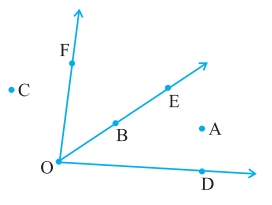(a) Write the reaction that occurs when glucose breaks down anaerobically in yeast.
(b) Write the mechanism by which fishes breath in water.
(c) Name the balloon like structures present in lungs. List its two functions.
(d) Name the respiratory pigment and write its role in human beings.
(a) Break down of glucose anaerobically in yeast
Glucose Glycolysis−−−−−−−−−→in the cytoplasm Pyruvic acid In the absence −−−−−−−−→ of oxygen2C2H5OH+2CO2+2ATP
(b) The fisher have special organs of breathing called 'gills'. The fish breathes by taking in water through its mouth and forces it past the gills, the gills extract dissolved oxygen from this water which is then taken up by the blood. The water then goes out through the gills slits.
(c) The balloon like structures present in lungs are called alveoli.
Two funcations
(i) The alveoli provide a surface where the exchange of gases can take place.
(ii) The walls of alveoli are covered by extensive network of blood vessels or capillaries in which oxygen from alveoli dissolves and are carried by the blood to the hear for pumping . In the same way, carbon dioxide from the body cells are carried by the blood capillaries to the alveoli from where it goes out of the body.
(d) In human beings, the respiratory pigment is haemoglobin which has a very high affinity for oxygen. This pigment is present in the red blood corpuscles.
Similar Questions
(a) Write the Haworth structure of maltose.
(b) What is peptide linkages? How many peptide bonds are present in a tetrapeptide?
(c) Name the hormone which regulates blood sugar level in the body.
View Solutionwhen the solid A is added to water , it dissolves with the evolution of a lot of heat and making little explosions to from two products B and C ,The properties of products B and C are entirely different from those of solid A as well as water ,Moreover ,Products B and C cannot be reconverted into solid A and water ,when another solid D is added to water ,it dissolves with the absorption of little heat to form a product E which cools down ,The product E sows the properties of both , solid D as water ,Moreover , product E can be converted into solid D and water .
( a) what type of change occurs when solid A is dissolved in water ? why ?
(b) what type of change occurs when solid D is dissolved in water ? why
(c ) Name a metal which you think could behave like solid A .Also name the products B and c .
( d) Name the solid D if ti is the one which is used in making ordinary dry cells .
( e) name the process by which D can be recovered form E .
View SolutionCompound X and aluminium are used to join railway tracks. (a) Identify the compound X (b) Name the reaction (c) Write down its reaction.
View SolutionWrite the reactions of D-glucose which can't be explained by its open chain structure. How can cyclic structure of glucose explain these reactions?
View Solution(i) Write the product obtained when D-glucose reacts with HCN.
(ii) What type of bonding stabilizes the α-helix structure of proteins ?
(iii) Write the name of the disease caused by the deficiency of vitamin B12.
View Solution(a) Name the organ that produces sperms as well as secretes a hormone in human males. Name the hormone it secretes and write its functions.
(b) Name the parts of the human female reproductive system where fertilization occurs.
(c) Explain how the developing embryo gets nourishment inside the mother's body.
View Solution(a) Identify three triangles in the figure. (b) Write the names of seven angles. (c) Write the names of six line segments. (d) Which two triangles have <Bas common?

View Solution(a) Mention any two components of blood.
(b) Trace the movement of oxygenated blood in the body.
(c ) Write the function of valves present in between atria and ventricles.
(d ) Write one structural difference between the composition of artery and veins.
View SolutionNo chemical reaction takes place when granules of a rusty brown solid A are mixed with the powder of another solid B. However, when the mixture is heated, a reaction takes place between its components. One of the products C is a metal and settles down in the molten state while the other product D floats over it. It was observed that the reaction is highly exothermic.
(a) What could the solids A and B be ?
(b) What are the products C and D most likely to be ?
(c) Write the chemical equation for the reaction between A and B leading to the formation of C and D.
Mention the physical states of all the reactants and products in this equation and indicate the heat change which takes place.
(d) What is the special name of such a reaction ? State one use of such a reaction.
(e) Name any two types of chemical reaction under which the above reaction can be classified.
View SolutionAn element belongs to third period and second group in the periodic table.
(a) State number of valence electrons in it. (b) Is it a metal or non-metal ?
(c) Name the element (d) Write the formula of its oxide
View Solution

